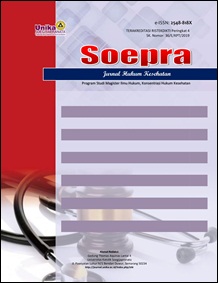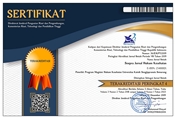Comparative Study of Sex Selection in Assisted Reproductive Technology’s Regulation Between Indonesia and England
Abstract
Sex selection through assisted reproduction technology can be done by sperm sorting and Pre-Implantation Genetic Diagnosis (PGD) However, there were different regulations in many countries. This study aims to determine the regulation of sex selection with assisted reproductive technology in Indonesia and its comparison with other countries, namely the United Kingdom. This research was a normative study with a comparative and statue approach. Based on research, regulations regarding sex selection with assisted reproduction in Indonesia have been regulated in Government Regulation No. 61 of 2014 concerning Reproductive Health. Indonesia legalizes sex selection by assisting reproduction for second and subsequent children without differentiating the underlying medical and non-medical reasons. The sex selection method regulated in the regulation is the sperm sorting method, whereas, for the PGD method. It has not been regulated further, Indonesia does not yet have further regulations regarding the implementation of sex selection by assisting reproduction along with negative excesses that can occur. Whereas the UK legalizes the selection of sex by assisting reproduction for serious medical reasons and does not allow for non-medical reasons. The sex selection method regulated in the regulation is PGD. Organizing sex selection in the UK will be done after obtaining a license from the Human Fertilization and Embryology Authority (HFEA).
Keywords
Full Text:
PDFReferences
A.Nyboe Andersen, L. Gianaroli, R. Felberbaum, J. de Mouzon, dan K.G. Nygren. 2001. Assisted Reproductive Technology in Europe, 2001. Results Generated from European Registers by ESHRE. Human Reproduction Vol. 20, No. 5, pp 1158-1176, January 21, 2005. Doi : 10.1093/humrep/deh755
Abby Lipman, Note. Prenatal Genetic Testing and Screening: Constructing Needs and Reinforcing Inequities, 17 Am.J.L & MED,.15.24. 1991
Ethics Committee of the American Society for Reproductive Medicine. 2015. Use of reproductive technology for sex selection for nonmedical reasons. Fertility and Sterility Journal, Volume 103, Issue 6, June 2015, pp. 1418-1422. https://doi.org/10.1016/j.fertnstert.2015.03.035
Human Fertilisation and Embriology Authority. Sex Selection :Choice and responsibility in human reproduction. 2003.
Marcy Darnovsky. 2004. Revisiting Sex Selection: The Growing Popularity of New Sex Selection Methods Revives an Old Debate, GENEWATCH
Neil Samson Katz. 2006. Abortion in India: Selecting by Gender, WASH. POST, For a discussion of the motivations underlying sex selection in China and India
Taylor A. A guide to preimplatation genetic diagnosis. Galton Institute Occasional Paper, Third Series no.1; 2008
Simon Parry. 2005. Shortage of Girls Causes China to Criminalise Selective Abortion, Telegraph (London)
Soerojo Wignjodipoero. 1988. Pengantar dan Asas-Asas Hukum Adat. Jakarta : PT. Lawang Kencana Indah
Subiyanto, Muchsin Jaffar, Yuslam EF. Etika dalam Teknologi Reproduksi Manusia. Simposium Mencegah Konflik Etik, Pertemuan IlmiaTahunan (PIT) XIII POGI. Malang, 28 Juni- 3 Juli 2002.
Undang-Undang Dasar Negara Republik Indonesia Tahun 1945
Undang-Undang Nomor 1 Tahun 1974 tentang Perkawinan
Undang-Undang Nomor 39 tahun 1999 tengan Hak Asasi Manusia
Undang-Undang Nomor 36 Tahun 2009 tentang Kesehatan
Peraturan Pemerintah Nomor 61 Tahun 2014 tentang Kesehatan Reproduksi
Peraturan Menteri Kesehatan Nomor 43 tahun 2015 tentang Penyelenggaraan Pelayanan Reproduksi dengan Bantuan atau Kehamilan di Luar Cara Alamiah.
Peraturan Menteri Kesehatan Nomor 833/Menkes/Per/IX/2009 tentang Penyelenggaraan Pelayanan Sel Punca
HFEA Acts 8th Code of Practice. 2009. www.hfea.gov.uK
Human Fertilization and Embriology Act. 2008. www.legislation.gov.uk
The Abortion Act 1967. www.legislation.gov.uk
DOI: https://doi.org/10.24167/shk.v6i1.2627
Refbacks
- There are currently no refbacks.
Copyright (c) 2020 SOEPRA







